
Off to War

For Richard Bong, the best part of combat fighter training was leaving behind the clunky and slow training planes he flew as a cadet. It was time for the real thing, the new Lockheed P-38 Lightning. The P-38 was bigger, faster, and more powerful than any plane Richard had flown before. He fell in love with it immediately. “Wooey! What an airplane,” he wrote home. “That’s all I can say, but that is enough.”
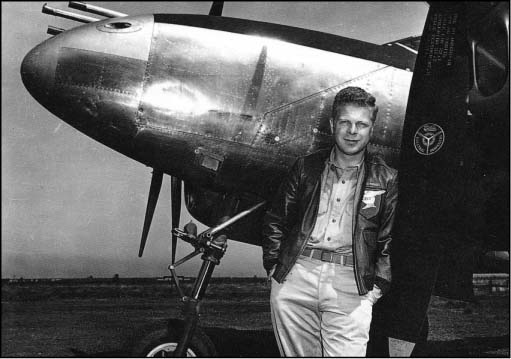
Richard loved flying the P-38 Lightning.
Not everyone had such kind words for the P-38. Much bigger than its cousins the P-39 and P-40, the P-38 looked more like a small bomber, loaded with heavy bombs, than a fighter plane. With huge 1,000- horsepower engines and protective armor, it weighed more than 15,000 pounds. That’s as much as the weight of 5 cars! The “P” in P-38 stood for “pursuit” plane, which meant it was a plane that chased enemy planes in order to shoot them down. But some people felt the P-38 was too cumbersome to perform well against the agile Japanese fighter planes. The quick-turning Japanese Zero and other combat planes had already shot down hundreds of American planes over the Pacific. Some people feared the P-38 would meet the same fate. But they would soon be proven wrong.
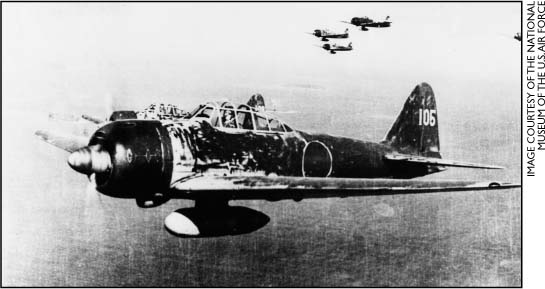
You could tell a Japanese Zero by the “O” on its side.
With a top speed of 395 miles per hour, the P-38 was one of the fastest American planes in the war. It could climb to an incredible 39,000 feet. From there it could launch surprise attacks on enemy pilots who couldn’t see it so high above them. Four .50-caliber machine guns and a powerful 20 mm cannon were buried in the plane’s nose. These guns made sure that enemy planes could not escape a direct hit. Having twin engines meant the P-38 could fly longer distances than other fighters, because they needed only one engine to fly. When one engine was damaged, the plane could still return to base. Pilots quickly learned to overcome the P-38’s slow turning abilities by diving down on enemy planes and speeding away. The agile Japanese fighter planes would soon be challenged.
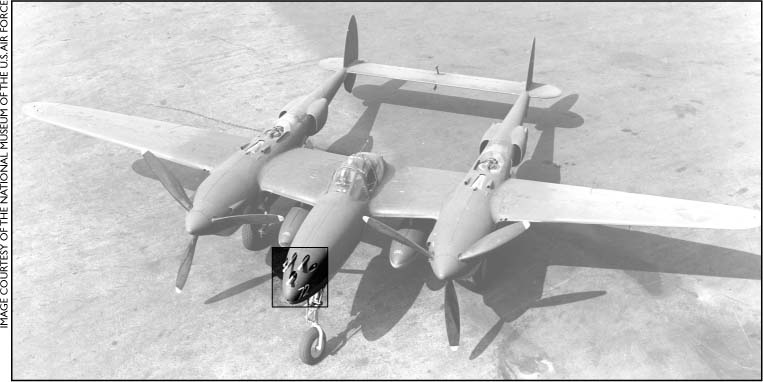
Four machine guns poke out of this P-38’s nose.
Early in the war, Japanese and German airplanes ruled the skies. Their pilots were excellent, and their planes were as good as anything the Allies flew. But after America joined the war, American planes were clearly better. By 1943, U.S. Navy planes such as the F6F Hellcat and the F4U Corsair were knocking Japanese Zeros out of the sky. Army Air Force planes such as the P-38 Lightning and the P-47 Thunderbolt were also successful. America’s greatest fighter plane was probably the P-51 Mustang. It was fast, powerful, and able to fly from Chicago to Los Angeles without refueling. American factories produced these planes in record numbers. In 1944, the United States produced more airplanes than all of those made by the Japanese and Germans.
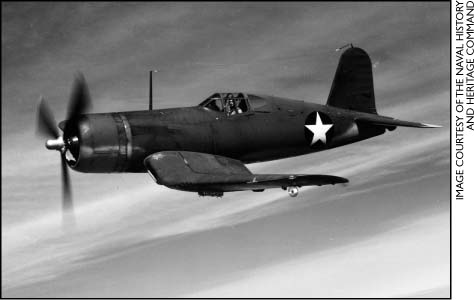
The F4U Corsair was a favorite among American pilots.
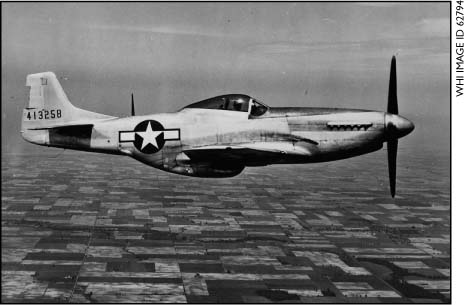
Many consider the P-51 Mustang America’s greatest fighter plane.
At Hamilton Field, Richard and his fellow combat pilots learned to love the power and speed of their new planes. Richard thought the P-38 was easy to fly. He spent many hours learning combat maneuvers, shooting at targets in the air and on the ground, and learning his way around the skies above San Francisco. When not in the air he had little to do but relax and enjoy himself. “All I do around here is go bowling and play ping-pong and sleep when I’m not flying,” he reported to his mother.
Just when it looked as though Richard would soon be leaving the United States for his first combat post, he was grounded for making a flight that wasn’t allowed. One of his friends had just been married and lived close to the air base in San Anselino (san an suh lee noh). To celebrate, Richard buzzed low over his friend’s house. Neighbors scattered in fear at the roar of the low-flying plane. One woman called the base, complaining that her laundry had been blown from the clothesline and that she had spilled her dinner all over the kitchen as she dove for cover. Richard’s commanding officer, General George Kenney, was furious.
Richard could have been kicked out of the Army Air Force because of his stunt. Flying low over people’s homes was a serious offense. Luckily for Richard, several other pilots were caught playing similar tricks. His friend Bob O’Neill (oh neel) and 2 others were busted for flying underneath the Golden Gate Bridge on that same day.
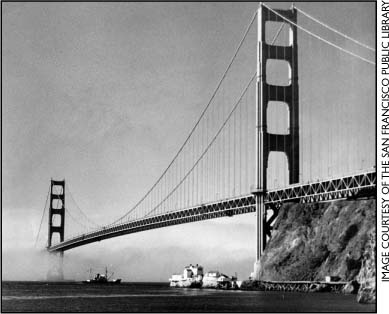
Only a very bold pilot would attempt to fly underneath the Golden Gate Bridge.
The Army Air Force needed talented pilots. Few officers wanted to lose men like Richard Bong because of one mistake. Richard was also lucky that General Kenney liked him. Kenney was commander of the Fifth Air Force. He was busy planning for a base in New Guinea (gin ee) where 50 P-38s would join a group of P-40 Warhawks and P-47 Thunderbolts. It would be their job to defend Australia and the South Pacific from Japanese attack. General Kenney knew Richard’s reputation as a talented pilot and a good person. Richard was just the type of pilot Kenney needed for his new attack force. He didn’t want to send Richard home, but he planned to give him a good scare to teach him a lesson.
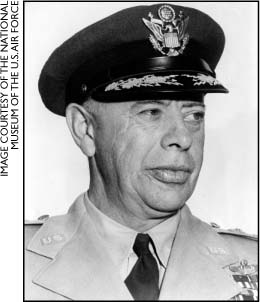
General George Kenney of the Fifth Air Force.
General Kenney called Richard into his office and yelled at him for taking risks with his airplane. He reminded Richard of the thousands of soldiers dying in the war and accused him of not taking his job seriously. Kenney’s voice grew louder and louder. The quiet farm boy stood, nervously awaiting his fate. He expected the general to demand his pilot’s wings and to send him back to Wisconsin. Instead, Kenney reminded him that he was a busy man and did not like receiving phone calls about his pilots’ bad behavior. Richard would have to write a 5,000-word paper on safe flying and read it to the entire squadron. He would be grounded for 6 weeks. Finally, he would report to the woman whose laundry he had ruined and help her with chores for a day.
Richard felt a huge sense of relief. Six weeks was a long time to go without flying, but it was a lot better than being kicked out of the Army Air Force. Richard promised not to make the same mistake again and quickly left Kenney’s office. But he would be seeing more of General Kenney in just a few months.
Military Ranks
Military ranks tell us the order of power. You can tell a person’s rank by the symbol—like a star or a leaf—on his or her uniform. Generals are at the top, and cadets are at the bottom. From the top down, the order of military rank is
General
Brigadier General
Colonel
Lieutenant Colonel
Major
Captain
Lieutenant
Cadet

General

Lieutenant Colonel
The higher the rank, the more soldiers the officer commands. For example, a lieutenant is usually in charge of about 50 soldiers. While in the Army Air Force, Richard Bong moved all the way from cadet to major.
As Richard counted the days until he could fly again, World War II raged on in 60 different countries around the globe. The German blitzkrieg, or “lightning war,” had forced much of Europe into Nazi hands. Poland, Denmark, Belgium, France, and many other countries could not defend themselves from the heavy air attacks from the German Luftwaffe (luft vah fuh) air force or stop German tanks from rolling across their borders. The American military had joined the British and the Russians in the fight against the Nazis after Pearl Harbor, but Hitler’s army was a powerful enemy.
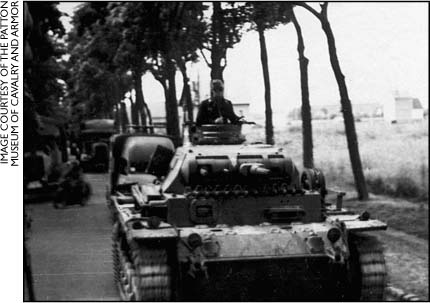
German tanks swept across Europe early in the war.
In the east, Japan continued to control the entire Pacific region. American troops in the Pacific were led by General Douglas MacArthur. MacArthur was forced to abandon the Philippines (fil uh peenz) when more than 2 million Japanese soldiers defeated the 130,000Americans stationed in the area. Like Germany, Japan had taken control of many of the countries closest to it: Thailand (tı land), Guam (gwahm), Burma, and Borneo (bor nee oh). Now it was threatening Australia. A Japanese submarine even fired shells at the California coast, the first attack on American soil since the War of 1812.
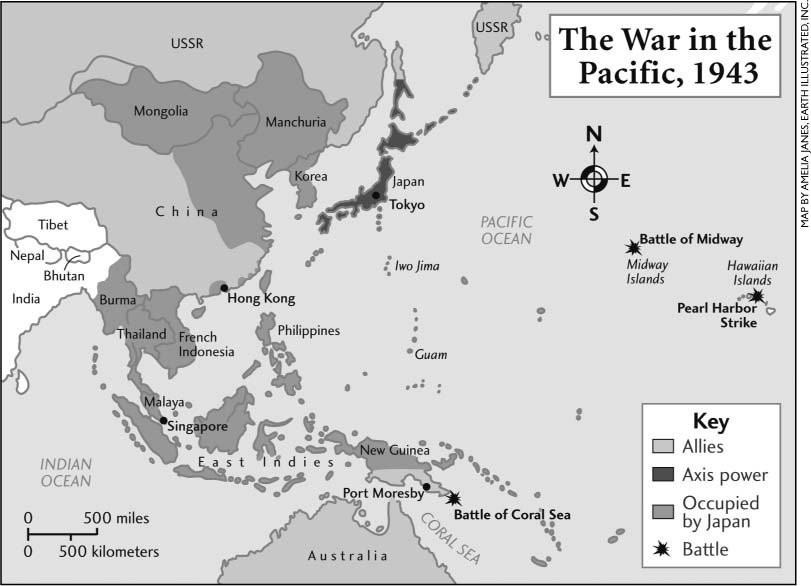
The war for control in the Pacific was long and fierce.
The Americans soon began fighting back. Lieutenant Colonel James Doolittle led a group of B-25 Mitchell bombers in a surprise attack on Tokyo in April of 1942. The attack shocked the enemy and encouraged many frightened Americans. That May, the American and British navies were able to push Japan back from New Guinea and Australia at the Battle of Coral Sea. Still confident it could crush the U.S. Navy, the Japanese navy attacked the U.S. base at Midway Island just a month later. But Japan’s luck had changed for the worse. When the Americans decoded Japanese radio messages and discovered the Japanese battle strategy, American dive-bombers launched a counterattack that destroyed 4 Japanese aircraft carriers, 300 planes, and more than 3,500 men.
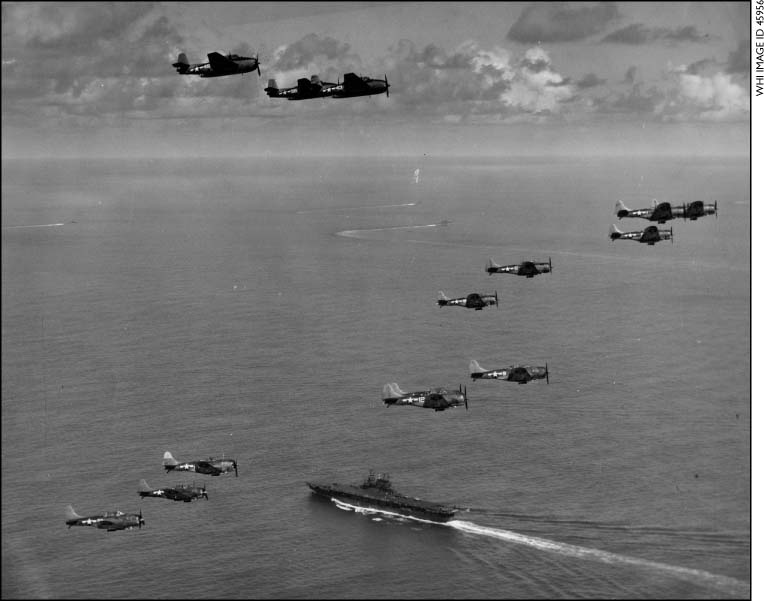
The Japanese did not think the Americans would be so powerful in the air.
After this defeat the Japanese only fought harder. The Japanese were proud of their nation. Their desire to serve Emperor Hirohito, the Japanese leader, made many Japanese soldiers fight to the death. Japanese soldiers often blew themselves up with hand grenades rather than become prisoners. Japanese pilots nicknamed “kamikaze” purposely crashed their planes into American warships. The struggle in the Pacific would last 3 more years and cost millions of more lives before it ended.
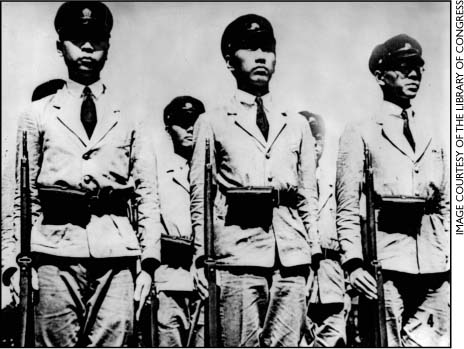
Even after terrible defeats the Japanese refused to surrender.
General Kenney finally received the promised 50 P-38 Lightnings in September of 1942. Richard Bong was one of the first pilots he chose to fly these powerful planes. Richard was excited at the news and immediately began getting ready for his departure. He wrote a short letter to his mom before boarding the transport plane to New Guinea. In the letter he predicted his own future: “I won’t see home until the war is over, unless I get over there and become a hero so they send me home for a couple months.”
Richard did become a war hero and was sent home twice by his officers in recognition of all he had done. But first he would face hundreds of hours in fierce combat and survive many close calls with death.